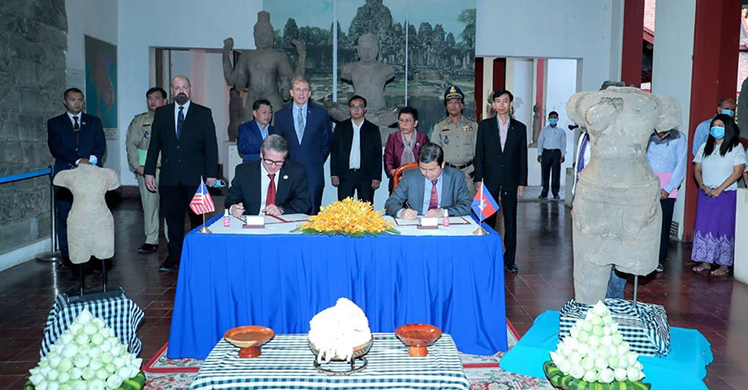Archived Content
In an effort to keep ICE.gov current, the archive contains content from a previous administration or is otherwise outdated. This information is archived and not reflective of current practice.
2 historic Khmer statues returned to Cambodia
WASHINGTON – U.S. Immigration and Customs Enforcement’s (ICE) Homeland Security Investigations (HSI), in conjunction with the U.S. Department of State and Cambodia Ministry of Culture and Fine Arts, returned two Khmer statues to Cambodia during a repatriation ceremony at the National Museum of Cambodia April 3.
The first item is an 11th Century sandstone Khmer statue torso of the Khleang style wearing a Khmer sampot, a traditional garment of Cambodia. The statue was part of an administrative seizure in 2017, when HSI San Francisco received information regarding the sale at an auction house in California. The auction house owner said the piece was imported in 1992 with a certificate of authenticity issued in Bangkok, Thailand, which identified the item as “Body of Khmer in Angkor Wat.” The antiquity expert determined the statue had a fair market value of $75,000.
The second item, dated between the early 10th to late 10th century, is a large gray sandstone Khmer statue torso of an unidentified deity. The item was a part of a criminal seizure in September 2005, when the Department of Homeland Security, U.S. Customs and Border Protections and HSI Los Angeles confiscated it from a partial shipment of goods that arrived in the United States from Thailand. Experts value this statue at about $120,000.
“On every return of Khmer artifacts from abroad, it is a testament to the fact that a full cooperative and peaceful partnership exists, the result of efforts by the Royal Government of Cambodia and United States government, to make possible the return of the statues that have left the country,” said Cambodian Minister of Culture and Fine Arts Dr. Phoeurng Sackona.
In 2018, Cambodia signed a historical memorandum of understanding with the United States titled “The Imposition of Import Restrictions on Categories of Archeological Material of Cambodia.” The agreement aims to reduce the incentive for the pillage of irreplaceable archaeological materials representing Cambodia’s rich cultural heritage.
“As we celebrate the 70th anniversary of the establishment of U.S. – Cambodia diplomatic relations, today’s return of these two statues serves as a reminder of what our two countries have achieved together,” said U.S. Ambassador to Cambodia W. Patrick Murphy.
During the repatriation ceremony, the government of Cambodia presented HSI a letter of appreciation extending profound gratitude and appreciation for the agency’s assistance repatriating the two Khmer Statues.
“The attention to details exemplifies the U.S. government agencies’ professionalism and serves as a model for cooperation of experts worldwide in the efforts to stop the illegal trade of precious and irreplaceable patrimony of the Kingdom of Cambodia. The work of the U.S. embassy in coordination with Homeland Security not only protects cultural heritage, but also reinforces the UNESCO 1970 Convention on the Means of Prohibiting and Preventing the Illicit Import Export and Transfer of Ownership of Cultural Property,” said Sackona.
HSI’s International Operations, through its 80 offices in 53 countries, works closely with foreign governments to conduct joint investigations, and is committed to pursuing a strategy to combat transnational organized crime related to the illicit trafficking of cultural artifacts by targeting high-priority organizations and strengthening international law enforcement partnerships.
ICE has recovered and returned approximately 12,500 artifacts to more than 30 countries since 2007, including paintings from France, Germany, Poland and Austria; cultural artifacts from China and Cambodia; dinosaur fossils from Mongolia; and illuminated manuscript left from Italy; a pair of royal Korean seals, ancient Peruvian ceramics, an ancient gold coffin repatriated to Egypt, and most recently, more than 500-year-old copy of Christopher Columbus’ letter describing his discoveries in the Americas to the Government of Italy.
Despite increasingly aggressive enforcement efforts to prevent the theft of cultural heritage and other antiquities, the illicit movement of such items across international borders continues to challenge global law enforcement efforts to reduce the trafficking of such property. Trafficking in antiquities is estimated to be a multi-billion-dollar transnational criminal enterprise.
Members of the public who have information about the illicit distribution of cultural property, as well as the illegal trafficking of artwork, are urged to call the toll-free tip line at 1-866-DHS-2-ICE or to complete the online tip form.


